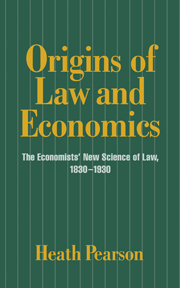1 - A new science
Published online by Cambridge University Press: 12 January 2010
Summary
The century preceding 1914 saw momentous change in the way scholars thought about society and its institutions. The primacy of the universal gave way to that of the peculiar and the evolutionary, while the causal efficacy of Ideas was derogated in favor of Matter. This study explores one important aspect of that phenomenon, namely, the increasing conviction on the part of economists that their worldly science had something germane to contribute to the understanding of law.
Why should not the production and distribution of rights be subject to economic analysis? After all, exchange in the marketplace – the economist's undisputed domain – entails above all the exchange of rights and obligations and may or may not involve the physical transfer of goods. Departing from this simple insight, one may sensibly deduce a natural affinity between the concerns of economics and the data of civil law. Indeed, most contemporary economists will assent to the proposition that economic concepts help to explain the regime of rights and obligations under which an economy operates. Economists untutored in the history of their discipline might well argue that the connection is intrinsic and must always have been patent; others would gainsay this, on the basis of a conventional intellectual history that begins with Ronald Coase's 1937 article “The Nature of the Firm,” goes on to the work of Alchian, Demsetz, Posner, North, and many others, and culminates in what is known today as the “law and economics” movement.
- Type
- Chapter
- Information
- Origins of Law and EconomicsThe Economists' New Science of Law, 1830–1930, pp. 5 - 42Publisher: Cambridge University PressPrint publication year: 1997

